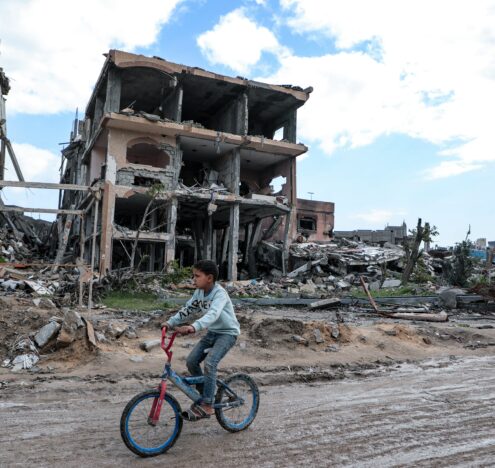The temperatures in DC are rising, which means: the interns are coming. Every year, right around the time the red line platform gets too warm for business casual, hundreds of interns swarm DC. As a former professional intern, I know just how intimidating DC can be… especially in the national security (or natsec) field. Everything is expensive, everyone is sweaty, and happy hour conversations about “wonky” policy are more terrifying than fun.
Accessibility is key, especially for interns who might be new to the field and looking to learn more. So, it’s time for another installment of DC Dictionary.
Managers, I would encourage you to never assume your intern knows what a weird acronym is. Also, to truly be accessible, it would be nice if you paid your interns. But, perhaps that’s a conversation for a later time. Interns, I sincerely hope this provides the foundation for a wonderful learning experience this summer. If not, just know that Front Page offers $3 Coronas on Thursdays and that Madhatter truly is not worth the hangover.
1. BUFF: “Big ugly fat fucker” (I am mainly including this to see if I can get away with publishing something with the word “fucker” in it…) “BUFF” is the slang word for the US Air Force (USAF) B-52 bomber, also known as the “Stratofortress.” Boeing produced the BUFF during the Truman administration, and the USAF expects to keep flying the plane until the 2050s. While the B-52 was originally intended to drop nuclear bombs, with the advent of GPS-guided weapons (aka guided missiles), the BUFF is now mainly used for close air support, particularly in Afghanistan and Iraq. However, because of USAF procurement issues (i.e. airplanes are just a tad expensive) B-52s will likely continue to also be used for nuclear weapons strategy and posturing for a while.
2. Boomer: A boomer is US Navy slang for a ballistic missile submarine, or a SSBN (ship, submersible, ballistic missile, nuclear powered). Basically, these are nuclear powered submarines that launch nuclear ballistic missiles (SLBMs = Submarine Launched Ballistic Missiles). It’s really as simple as: Boomers make things go boom.
3. MOAB: “Mother of all bombs” or the GBU-43/B Massive Ordnance Air Blast, is a large-yield bomb developed by the USAF. The MOAB, while conventional (i.e. not nuclear), is a big-ass bomb. So big-ass, in fact, that at the time of its development, it was considered to be the most powerful non-nuclear weapon in the US arsenal. It’s so big that it isn’t even carried by the BUFF, but by a “Hercules” (or C-130) instead. The MOAB was first used in a US airstrike in 2017 against an ISIS tunnel complex in the Achin district of Afghanistan. In case you haven’t gotten it yet… the MOAB is so big, it has an explosive yield comparable to that of the smallest “tactical” nuclear weapon, at 10 tons. That’s a “shit-ton,” so to speak, for a conventional weapon. But, for perspective, that yield is only 1/144,000th of the 1.44 megaton W49 nuclear warhead.
4. JASSM/ER: “Joint Air-to-Surface Standoff Missile” or the AGM-158 is a conventional standoff air-launched cruise missile (ALCM) introduced into service in 2009 by the USAF. It has largely been used in the Syrian Civil War. The JASSM is a “low observable” weapon, so, it’s pretty difficult to see, especially if you’re in the targeted zone. The “-ER” stands for “extended range.” As intuition would suggest, this means that the JASSM-ER has a longer range (925km) than the JASSM (370km). (No, the USAF isn’t that creative when it comes to missile acronyms.) In discussions surrounding the JASSM-ER, it has been suggested that it’s development and introduction to the current US arsenal could actually help to save the USAF money by retiring the “conventional air-launched cruise missile” or CALCM (a conventional version of the nuclear-tipped air-launched cruise missile (ALCM)). But don’t be deceived: it’s still a pretty pricey missile, going for around $1.359 million a pop.
5. LRSO: “Long Range Stand Off Weapon” is a nuclear tipped air-launched cruise missile (ALCM). The LRSO is set to replace the current AGM-86 ALCM, however it’s still in development. In case you thought this kind of thing was cheap… think again. Both Raytheon and Lockheed Martin both received $900 million contracts from the Department of Defense and USAF. These “development” contracts will end in 2022 and, in a twisted Project-Runway-like competition, the best design will “win” and get to continue further development. Talk about fierce. This new LRSO will have the ability to be carried on multiple aircraft, and will be able to evade missile defense systems (although, as recent tests show, that really isn’t too difficult…)
6. Iskander: The Iskander is a Russian short-range, road-mobile, solid fuel ballistic missile system. It was designed in the early 1970s by the Soviets, and was set to serve as a replacement to the “scud.” Scud missiles are “tactical” ballistic missiles developed by the Soviets during the Cold War. Today, “scud” is often used as a term to refer to short-range missiles with similar or variant designs. I’m including Iskander here because, recently, North Korea (the DPRK), has been launching short-range missiles (albeit not necessarily ballistic), and many people have argued that this missile design is similar to Russia’s Iskander. When it comes to missile design, perhaps sharing isn’t necessarily caring…
7. DOE: “Department of Energy.” Somewhat surprisingly, the Department of Energy actually plays an integral role in US nuclear weapons maintenance and development. Specifically, the National Nuclear Security Administration (NNSA) is “responsible for ensuring the integrity and safety of the nation’s nuclear weapons, advancing nuclear nonproliferation and promoting international nuclear safety.” That’s a fancy/bureaucratic way of saying that DOE, specifically NNSA, is responsible for designing, testing, and producing all of our nuclear weapons. DOE works closely with DOD (Department of Defense) and DOS (Department of State) to make sure nuclear weapons production mirrors official US policy. So, when thinking about nuclear weapons, always remember “DOE” doe.
I mean, there’s a lot of math to it and shit, but very basically there is a dome (or Circular Error Probable radius) around missile targets that the fuze (the thing that makes it go boom) of the missile is likely to detonate in.
8. C3: “Command, Control, and Communication” systems. Very basically, C3 systems are information systems that are used by military organizations to direct combat systems. Command refers to the authority, or person holding the authority, that is in charge of taking action to attain an objective or goal. The daddy of decision-making, if you will. Control refers to the process of verifying and correcting activities, and directions from command, in order to achieve the initial action. And communications refer to the ability to make sure that everyone is on the same page including understanding what the initial task from command was, and the process control respectively implements. Currently in the US nuclear C3 systems, the president is the sole command. That’s right: right now, Trump alone has the ability to launch nuclear weapons. Isn’t that a comforting thought?
9. Football: In natsec, the term football doesn’t refer to the sport(s), but rather the nuclear football. This is a black briefcase that an aide carries around by the president’s side. It’s an “emergency satchel” that is a mobile hub for the strategic nuclear defense system. The football carries the launch codes for US nuclear weapons. It’s often also referred to, especially by President Trump, as a “button.” However, despite Trump’s Tweets, the American football (or button) is not really any larger than Kim Jong-Un’s.
10. Biscuit: Not to be confused with a cookie, or starchy hunk of deliciousness meant to be smothered in gravy, the nuclear biscuit is a small plastic card the President holds at all times in order to be positively identified by the control operators as the actual commander. If there is an emergency, and the President chooses to launch his nuclear weapons, he must use his biscuit in tandem with the football in order to verify his identify. The release of the weapons must also be verified by the US Secretary of Defense (SecDef), but, the SecDef does not have any official veto power. Once the command has been verified, the attack orders are sent the various proper military units. As a fun fact: President Clinton once accidentally “misplaced” his nuclear biscuit. Whoops!
11. NORAD: “North American Aerospace Defense Command” Is the organization of US and Canada that provides aerospace warning and sovereignty protection for North America. They protect US airspace from critical threats, like missiles, and more terrifyingly: Santa Clause. Essentially, NORAD makes sure that sketchy shit doesn’t happen in our airspace.
12. POTUS: “President of the United States.” Generally speaking, anything that ends in “OTUS” means “of the United States.” Again, natsec folks really tend to not be the most creative. Other examples include: FLOTUS (First Lady of the United States), and SCOTUS (Supreme Court of the United States.
13. TEL: “Transport erector launcher” A TEL is a vehicle that launches missiles. It is basically a tractor-like unit that can carry, elevate to firing position, and launch one or more missiles. TELs are mainly used for surface-to-air and surface-to-surface missiles. TELs are nice because they mean a missile can be launched from almost anywhere, making them less vulnerable to attack than fixed launch sites. (Please note: Yes, as a grown adult it is okay to giggle at the word “erector”… just not in front of your boss.)
14. Super-Fuze: To be perfectly blunt, I am including this term because not a lot of people talk, or even know, about this application… and they really should. Plus, almost always, anything with the term “super” in it in nuclear issues is “super-critical” to know about. (See what I did there?) Recently, while conducting the life-extension process of the nuclear W76 warhead, the US Navy sneakily incorporated a new super-fuze to notably improve their ability to destroy targets. Usually, life-extension processes simply make sure a warhead can “live” longer — a standard maintenance check-up of sorts. So, adding a new feature during one of these routine check-ups is generally frowned upon (largely because it could be viewed as capacity building rather than simple modernization… a complex debate for another time). While I won’t go into the tricky science behind this process, like this article does, basically, this new super-fuze allows for adjustable “height-of-burst” for submarine launched ballistic missiles (SLBMs). As compared to the old fuze of the warhead, which was of a “fixed-height,” this new super-fuze can allow for targeting of “harder” objects, like ICBM silos (as opposed to softer targets, like military bases.) Basically, this new development nonchalantly made the US ballistic missile forces increase their “killing power” by a factor of three. That’s a lot. And, that’s pretty dangerous… especially to do so in the dark.
15. Kill Probability: The probability of a missile hitting a specific target. I mean, there’s a lot of math to it and shit, but very basically there is a dome (or Circular Error Probable radius) around missile targets that the fuze (the thing that makes it go boom) of the missile is likely to detonate in. To calculate the kill probability, or probability of completely destroying an intended target, you multiply the probability of the delivery system and warhead function correctly with the “single shot probability of kill” (which is calculated in tandem with the circular error probable radius.) This probability changes depending on the type of fuze and number of warheads. While this is a type of measurement of missile accuracy, it’s important to note that the probability of hitting a target and the probability of killing a target are two different measurements. Additional factors affecting kill probability (besides hit probability) include: probability of detection, reliability of targeting systems, and reliability of the weapons.
16. Accuracy vs. precision: Accuracy refers to closeness to the target whereas precise refers to how close to each other each strike of something is. An accurate missile is one that can continuously hit its target, whereas a precise missile doesn’t necessarily hit the target, but will hit the same place over and over again. So, in an ideal world, you want an accurate and a precise missile.
17. Hypersonic: Hypersonic is used to describe something that can travel more than five times the speed of sound (or about 1.6km per second). For weapons, you can either have a hypersonic cruise missile or a hypersonic boost-glide weapon. A hypersonic cruise missile is simply a fast regular cruise missile (surprise!). They’re powered by sucking in air which then powers their rockets/jets. (Think of a flying death vacuum). Hypersonic boost-glide weapons are a little more unique; they are launched into the upper atmosphere on top of an existing ballistic missile, and then, the glide vehicles are released. These glide vehicles, unlike a traditional re-entry vehicle, fly almost like a cruise missile, going lower and faster than its older counterpart. It can also move more unpredictably, which is why everybody freaks out about it being able to evade missile defense systems. (But, hot take: missile defense systems aren’t really even that good at taking down the old re-entry vehicles, so everyone can calm down).
18. Stealth: Stealth basically means sneaky. Stealth technology is also referred to as low observable technology. So, stealth is an umbrella term describing passive and active electronic counter measures used by all sorts of things (people, aircraft, ship, subs, missiles, satellites, etc.) and aims to be less visible, or even invisible to the wide range of detection methods (like radar, infrared, and sonar). Stealth technology is dangerous because if you can’t see an incoming weapon, how are you supposed to stop it?
19. Mating: Mating refers to pairing up a delivery system with a warhead. (Yes, you’re also allowed to giggle at this term.) So, while warheads are dangerous in and of themselves, they’re even more dangerous after they’ve been mated with a delivery vehicle that will, you guessed it, deliver them to their target. De-mating refers to removing a warhead, or storing a warhead separate, from a missile. (Insert a joke about de-mating with a regrettable hookup here.)
20. Dial-a-yield: Also referred to as a variable yield, dial-a-yield is an option that is available to most modern nuclear weapons where the operator has the ability to specify a weapon’s yield, or, you guessed it, “dial-a-yield.” The best example of a dial-a-yield warhead is the Mod-10 B61 bomb which has a selectable explosive yield of .3, 5, 10, or 80 kt (kilotons). This technology has existed since the 1950s, and arguably, could be a counterpoint against creating “low-yield” nukes.
21. LYN: “Low-yield nuke” because apparently an acronym exists for everything. While there is no precise range or yield that specifically categorizes a nuke as “low-yield,” as the name would suggest, these weapons have a lower yield than a traditional nuke. Low yield nukes can also be referred to as “tactical nuclear weapons” (TNW), or non-strategic nuclear weapons, and were designed to be used on a battlefield in a military situation. High, or “normal” yield weapons are often referred to as “strategic” nuclear weapons, which are designed to be targeted away from the war front against military bases, cities, etc. Recently, there has been a lot of talk about developing low-yield nuclear weapons, from the US attempting to create a low-yield D-5 SLBM, to Russia “likely conducting” low-yield nuclear weapons tests. Some arguments against low-yield weapons have been that they make nuclear weapons “more useable,” which is kind of a scary thought.
22. Plutonium Pit: The “pit” in a nuclear weapon is the core of an implosion nuclear weapon (i.e. where the fission associated with nuclear weapons occurs). In the pit, there is the fissile material (which, in the past has included uranium-235 (U-235), but now mainly only includes plutonium), and the neutron reflector (something that helps sustain the fission reaction). Like a fruit, the pit is the hard center of the weapon. Isn’t that just peachy!
23. Centrifuge: A centrifuge is a device that applies centrifugal force to an object. That’s a boring way of saying that it’s something that spins shit really fast. In nuclear weapons talk, centrifuges are used to separate isotopes of uranium. Isotopes are atoms that have a different number of neutrons than the OG atom/element, and therefore a different mass. During the enrichment process, or when then isotope is in the centrifuge, the isotope uranium-238 (u-238) is heavier than the more fissionable uranium-235 (u-235) and therefore will stick to the walls of the centrifuge as it spins. The desired u-235 can then be successfully extracted. U-235 is what is needed to sustain a successful fission reaction for nuclear reactors and weapons. You need to centrifuge the hell out of u-238 to extract the u-235 used in a nuclear weapon (i.e. 90% enriched uranium), and a little less for a nuclear reactor (around 3.5% enrichment).
24. LEU/ HEU: Low-enriched uranium vs. high-enriched uranium. (As a side pro grammar tip: never capitalize the name of an element.) Enriched uranium is uranium where the composition of u-235 has been increased through isotope separation (i.e. enrichment/ through a centrifuge). Natural uranium, or uranium that come straight from a mine, is about 99% u-238. Low enriched uranium is about 20% u-235, and 80% u-238. This LEU can be used for nuclear reactors. High enriched uranium is about 20-85% u-235, and is considered “weapons grade.” U-235 is needed because it is fissile (i.e. it can sustain a fission chain reaction), and being fissile is what makes something with nuclear in the title, well, nuclear.
25. Reprocessing: After LEU is used in a nuclear reactor, the nuclear waste is classified as “spent” fuel. This spent fuel can either be left as waste, or reprocessed. Reprocessing is a “series of chemical operations that separates plutonium and uranium” from the rest of waste. The separated plutonium is what causes worry as it can be used to continue to fuel reactors, OR to make a weapon. Reprocessing is the second pathway to getting nuclear material for a weapon (enrichment is the first) – meaning it can work directly against nonproliferation goals. And, as less than 20 pounds of plutonium is needed to make a simple bomb, reprocessing can be dangerous, if not monitored. Just remember, when reprocessing, you have to be really careful.




















